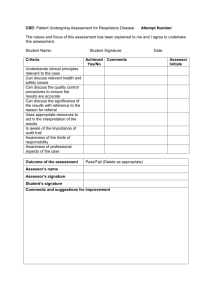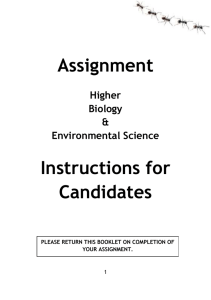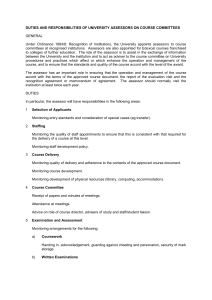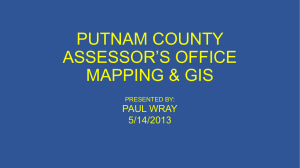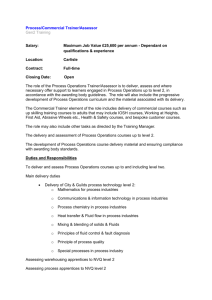Appendix 1: Instructions for candidates
advertisement
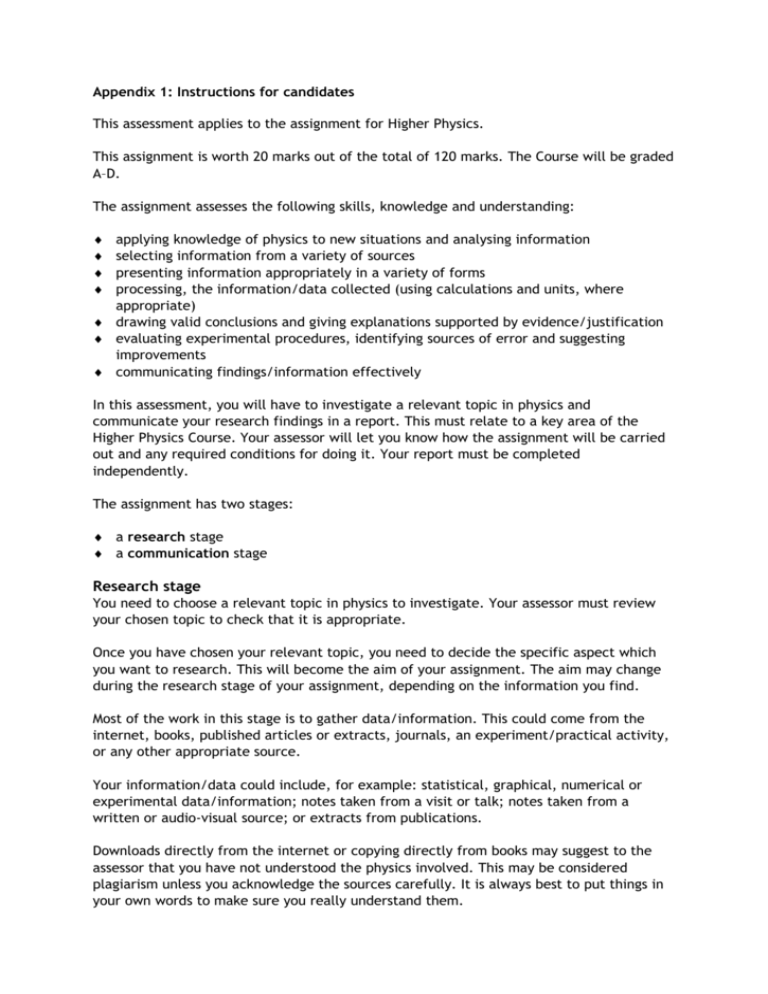
Appendix 1: Instructions for candidates This assessment applies to the assignment for Higher Physics. This assignment is worth 20 marks out of the total of 120 marks. The Course will be graded A–D. The assignment assesses the following skills, knowledge and understanding: applying knowledge of physics to new situations and analysing information selecting information from a variety of sources presenting information appropriately in a variety of forms processing, the information/data collected (using calculations and units, where appropriate) drawing valid conclusions and giving explanations supported by evidence/justification evaluating experimental procedures, identifying sources of error and suggesting improvements communicating findings/information effectively In this assessment, you will have to investigate a relevant topic in physics and communicate your research findings in a report. This must relate to a key area of the Higher Physics Course. Your assessor will let you know how the assignment will be carried out and any required conditions for doing it. Your report must be completed independently. The assignment has two stages: a research stage a communication stage Research stage You need to choose a relevant topic in physics to investigate. Your assessor must review your chosen topic to check that it is appropriate. Once you have chosen your relevant topic, you need to decide the specific aspect which you want to research. This will become the aim of your assignment. The aim may change during the research stage of your assignment, depending on the information you find. Most of the work in this stage is to gather data/information. This could come from the internet, books, published articles or extracts, journals, an experiment/practical activity, or any other appropriate source. Your information/data could include, for example: statistical, graphical, numerical or experimental data/information; notes taken from a visit or talk; notes taken from a written or audio-visual source; or extracts from publications. Downloads directly from the internet or copying directly from books may suggest to the assessor that you have not understood the physics involved. This may be considered plagiarism unless you acknowledge the sources carefully. It is always best to put things in your own words to make sure you really understand them. You must: Select sufficient sources of information/data that: — are relevant: how useful they are for your topic? — are reliable: who wrote them? who published them? — have similar/different perspectives: do they agree or disagree with each other? Select sufficient relevant data/information from your sources. This could include raw data from an experiment/practical activity, extracted tables, graphs, diagrams and text. Record the sources you have used with enough detail to allow someone else to find them again. If one of the sources is an experiment/practical activity, then you need to record the title and the aim. If you use an experiment/practical activity as one of the sources of information/data, your assessor will give you instructions for this. The experiment/practical activity will not be assessed and you may carry out the experiment/practical activity as part of a group. If you are working in a group to gather data/information, you must take an active part in this and choose your own sources of data/information. Checkpoint: inform your assessor that you have finished the research stage Communication stage In this stage of your assignment you need to select, process, present and analyse information/data from the sources you have gathered, and produce your report. This stage will be conducted under a high degree of supervision. This means that: You will be in direct sight of the assessor during the period of the assessment You must not discuss your work with other candidates In this stage of your assignment you can only use information/data that you have collected from your research. This may include, for example: statistical, graphical, numerical or experimental data; data/information from the internet; published articles or extracts; notes taken from a visit or talk; or notes taken from a written or audio-visual source. It cannot include a prepared draft report. As a guide, your report should be 800-1500 words, excluding tables, charts and diagrams. The table below shows how many marks are available for each aspect of your report. Criteria Aim(s) Applying knowledge and understanding of physics Selecting information Processing and presenting data/information Uncertainties Analysing data/information Conclusion(s) Evaluation Presentation Mark allocation 1 4 2 4 1 2 1 3 2 Guidance on producing your report Your report should: have an appropriate structure with an informative title and headings, where necessary be clear and concise Underlying physics should be included. Your report should contain: aim(s) experimental procedure data/information evidence of processing and analysing data/information conclusion(s) evaluation references Aim(s) The aim(s) must describe clearly what is to be investigated. Experimental procedure Here you must include a description of your experimental procedure. This may include clearly labelled diagrams. Data/information Here you must include sufficient data/information from your sources that is relevant to your investigation. This may include, for example, statistical, graphical, numerical or experimental data; data/information from the internet; published articles or extracts; notes taken from a visit or talk; notes taken from a written or audio-visual source. Processing and analysing data/information This must include data/information that you have processed from your sources. This can include, for example: performing calculations, including uncertainties, plotting graphs from tables, populating a table from other sources, summarising referenced texts, etc. It must be clear where the raw or extracted data/information that you processed came from. You must present your processed data/information in appropriate format(s) from: summary, graph, table, chart or diagram (one must be a graph, table, chart or diagram). Think carefully about the format(s) you choose because it must be suitable for the information you are presenting. Check that you have included, as appropriate: suitable scales units headings labels line of best fit Conclusion(s) You must clearly state the conclusion(s) of your investigation. Your conclusion(s) must relate to your aim and be supported by what you have found out. Evaluation This should include an evaluation of your individual sources and an evaluation of the investigation as a whole. You may include for example: significance/interpretation of findings validity of sources reliability of data/information evaluation of experimental procedure: — accuracy — adequacy of repetition — adequacy of range of variables — control of variables — limitations of equipment — reliability of methods — sources of errors, uncertainties Underlying physics Here you should explain how the underlying physics relates to your topic. You should include a statement of the physics principles involved. The response might include the use of physics concepts and principles: eg momentum and impulse, internal resistance, refraction, etc, as well as related formulae and calculations. References At the end of your report you must record the sources you have used, with enough detail to allow someone else to find them. If one of the sources is an experiment/practical activity, then you need to include the title and the aim. Before submitting your report, check that you have included everything you need.
